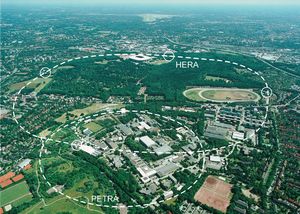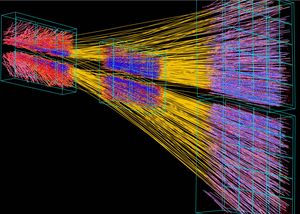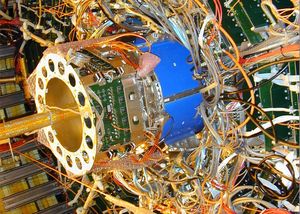Data preservation
The end of an experiment does not automatically mean that the scientific work is finished. Scientists often continue to work with the data that have been measured. This allows them to check current results on the basis of earlier data, for example. “Old” data may possibly reveal new findings long after the experiments are over - for example when they can be analyzed by means of new, improved methods.
It is therefore worthwhile preserving the data. In addition, significant investments are made in the setting up and operation of experiments. The objective should therefore be to keep the measurement data usable for a long period of time and to gain as much knowledge as possible from it.
The Max Planck Institute for Physics is actively involved in digitizing and reformatting data from past experiments for upcoming generations of researchers. Physicists and IT experts develop methods that will allow the IT systems of the future to process and evaluate data, analytical software and documentation as well. They frequently use so-called virtual machines which simulate past operating systems or applications on modern computers.

H1 and the other experiments (e.g. Hera-B and ZEUS) at the HERA accelerator ring showed that a proton is much more complex than previously assumed: It consists of a large number of quarks, antiquarks and gluons. H1 helped to prove that the electromagnetic and the weak nuclear forces are two aspects of a single electroweak force at high energies.
The H1 Group at the Max Planck Institute for Physics made crucial contributions to the construction of the main detector component, the liquid argon calorimeter, and developed all the read-out and trigger electronics for the calorimeter.
The Group has furthermore realized novel concepts to trigger the detector read-out. One example is the so-called “jet trigger”, which is able to trace all particle bundles produced in the electron-proton collision in the calorimeter within only 800 nanoseconds, and use them for a complex filtering of desired events.
And ten years or so ago, it had already developed and was operating the world’s only trigger to use artificial neuronal networks – whose architecture was modeled on that of the human brain – for the rapid and efficient recognition of patterns of interesting electron-proton scattering processes.
Both projects are examples of how modern electronics are used to approach physically complicated problems where time is of critical importance.
In the HERA-B experiment, interactions produced particles including heavy quarks such as “charm” and “beauty”. HERA-B was developed to investigate the CP violation with the beauty quarks. Particles and antiparticles here do not decay in the same way – which is a violation of CP (charge parity) symmetry. HERA-B published results in the charm quark sector and on quantum chromodynamics (QCD), the theory of the strong force. The Institute developed the modules for the silicon vertex detector.
ZEUS was a massive detector weighing 3,600 tons with a uranium scintillation calorimeter at its heart. This calorimeter recorded the bundled high-energy particles which are produced when protons are probed with electrons. The data evaluation has been providing answers about the proton structure and how QCD works up until today.
The OPAL experiment (Omni Purpose Apparatus at LEP) ran from 1989 to 2000 at the Large Electron-Positron Collider (LEP) at CERN near Geneva in Switzerland. LEP is the forerunner of the Large Hadron Collider (LHC) and was installed in the same tunnel at the end of the 1980s.
LEP’s objective was to generate collisions between electrons and positrons, their antiparticles, at extreme energies in order to be able to study what were then the newly discovered W and Z bosons in detail and to look for new phenomena.
Collisions between electrons and positrons generate pure energy, which gives birth to new particles. They are therefore produced under particularly simple and controlled conditions so that very accurate measurements are possible.
The OPAL experiment was one of four large experiments at the LEP and recorded several million electron-positron collisions, which were produced at energies corresponding to the mass of the Z boson (91.2 gigaelectronvolts, GeV) right through to the highest LEP energy of 209 GeV. In more than 300 publications, these data were used to establish the Standard Model of particle physics which is valid today.
The data from the OPAL experiment (and the other LEP experiments) are unique even today and cannot be replaced by other data, for example the LHC experiments. This explains why one Group at the MPP is engaged in preserving the data and the software needed to analyze them. The OPAL data can be used to investigate current issues of particle physics which arise as a result of new or improved theories. In recent years, researchers at the MPP have thus produced several papers which have been published in established journals and are frequently cited.
The subject of the NA49 experiment at the SPS accelerator at CERN was the investigation of high-energy collisions of lead nuclei. Such collisions transiently produce matter of extremely high density and temperature. The nucleons of the colliding nuclei dissolve into a state of quasi-free quarks and gluons (partons), the quark-gluon plasma (QGP). The early universe also passed through this unusual state of matter immediately after the Big Bang.
After rapid expansion and cooling, the QGP decays again into hadrons (baryons and mesons) which are registered in the detector. The measurements conducted by NA49 between 1994 and 2002 on the energy dependence of the production of many different types of hadrons showed that the transition into the QGP starts at a collision energy of around 7 gigaelectronvolts (GeV) per colliding nucleon pair in the center of mass reference frame.
The NA49 Working Group and the technical departments of the Institute developed and constructed crucial parts of the experiment, including the two large-volume time projection chambers, the forward calorimeter for selecting head-on collisions, and the data acquisition system.
The NA49 detector was handed over to the NA61 collaboration in 2007, which is using it to undertake a systematic investigation of the phase diagram of hadronic matter using a variety of nuclei. The results of NA49 form part of this program. The measurement data therefore continue to be made available at CERN to enable newly developed analytical methods to be applied to them and to publish the results.
The study of highly compressed and heated matter which started at the CERN SPS was continued in the STAR experiment at the RHIC (Relativistic Heavy Ion Collider, Brookhaven National Laboratory, USA). Compared with NA49,there collisions of gold nuclei were performed at even higher energies up to 200 gigaelectronvolts (GeV) per nucleon pair. The higher energy density and hence longer lifetime of the quark-gluon plasma (QGP) allows a more accurate measurement of the properties of this state of matter. From the results scientists concluded that the QGP behaves like an ideal fluid.
Furthermore, measurements of jet production (bundles of particles) with large transverse momentum demonstrated the expected strong energy loss in the QGP of the high-energy partons, from which the jets form (jet quenching). The high energy density of the QGP produced at the RHIC allows a comparison to be made with results from computations of QCD theory of the strong interaction in the non-perturbative regime (QCD simulation on a space-time lattice) for the first time.
STAR is also conducting a program of experiments with polarized protons to gain insights into the composition of the proton spin.
The contribution of the MPP to the STAR detector was the development and construction of the two time projection chambers (FTPC) with novel radial drift direction. These chambers expanded the measurement range of the central TPC into the region of small production angles.
STAR started to acquire data in 1999 and has expanded its measurements towards lower energies, which also cover part of the energy range of the CERN SPS. The experiment will remain active for several more years.

